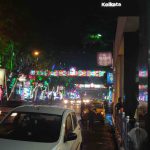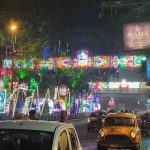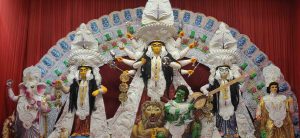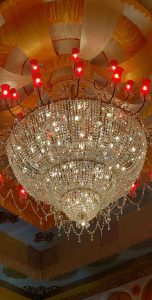We roamed around Park Street for a while, stepped into The Park hotel to check out their pub and then took an Uber to head back to South Kolkata – our destination was the Ladies Park (which is near the Maddox park we visited earlier on the trip) to see the aarti.
Our Uber driver kept accelerating and decelerating abruptly all through the trip. He kept cursing and honking as we got closer to our destination. Uber was expensive compared to Chennai for the same distances – but maybe it’s because of the festive season since there is so much demand.


Deb’s dad was a trustee in the group organizing the Ladies Park pandal. Along with the pandal, they had arranged for aartis (ceremony with lights) to be performed daily during the festival. Every pandal is sponsored by a committee – in many cases, you know the sponsor is a club because it would say so in the name itself – like the Ekdalia Evergreen Club pandal. Some of these Kolkata clubs have existed for decades.
Deb said, “In some society pujas, food is also served – typically for members”.
The pandal here was simple; simple is the wrong word because even the simple ones are grand. However, after you’ve seen the big-budget pandals, these neighbourhood ones are relatively simpler and smaller in scale. But these are the ones that feel homely since you don’t have the large crowds around; you can sit peacefully, have a conversation and not worry about being asked to keep moving. The Goddess here in her ten hands held ten different items (the conch, an arrow, a sword, a trident, etc.) – you don’t see this everywhere; depending on the artist and the theme of the pandal, they customize what she holds – sometimes it’s all 10 hands on the trident, or sometimes each hand has a different mudras (hand gestures). There is meaning to each of the items she holds, and each mudra also has a meaning.


Deb introduced us to his family members, and we took seats to watch the aarti.
“It all starts with the Mahalaya – the first day of Durga Puja”, he said.
And apparently, on the first day, there is an early morning broadcast in West Bengal on All India Radio about the background of the puja – the narrator describes the battle between the Goddess and the demon Mahishashura. The program is called ‘Mahisasuramardini’ (slayer of Mahishasura).
“This is done every year, and everyone listens to it. Every year at 4 in the morning. It’s so popular that they even sold CDs of the program.”
(On a related note – there is a hymn dedicated to the Goddess Durga that you will find online when you search for Mahisasuramardini).
The story
Durga puja begins on Mahalaya (the day when the Goddess is supposed to have descended to Earth), which happened to be on 28th September this year. Celebrations start on the 6th day (Sasthi). The 5th day is called Panchami, and that was the night we landed in Kolkata.
The story goes that the demon Mahishasura underwent strict penance for years (they call it ‘tapasya’) in the hope of getting more strength – in devotion, he fasted and prayed continuously; his intensity was such that the creator Brahma felt he had to be rewarded for his effort, and so he asked him what he would like to have. Mahishasura asked for immortality, but that was not possible since Brahma said everyone born has to die. And so he asked for the boon indirectly – that no man can kill him. He probably thought that since he was a strong demon, there was no way a woman could kill him. Brahma granted him his wish.
And what ensued was that the demon challenged the gods and none of the gods could defeat him because of the boon. And since no woman was strong enough to challenge the demon, the gods got together to bring Goddess Durga into existence. Each of the gods gave her their unique strengths and weapons – the chakra (discus), the trident, etc. (these are what you see her holding in her 10 hands).
The battle is said to have lasted for 9 days before the Goddess severed his head on the 10th day (called Vijayadashami) – the victory of good over evil.